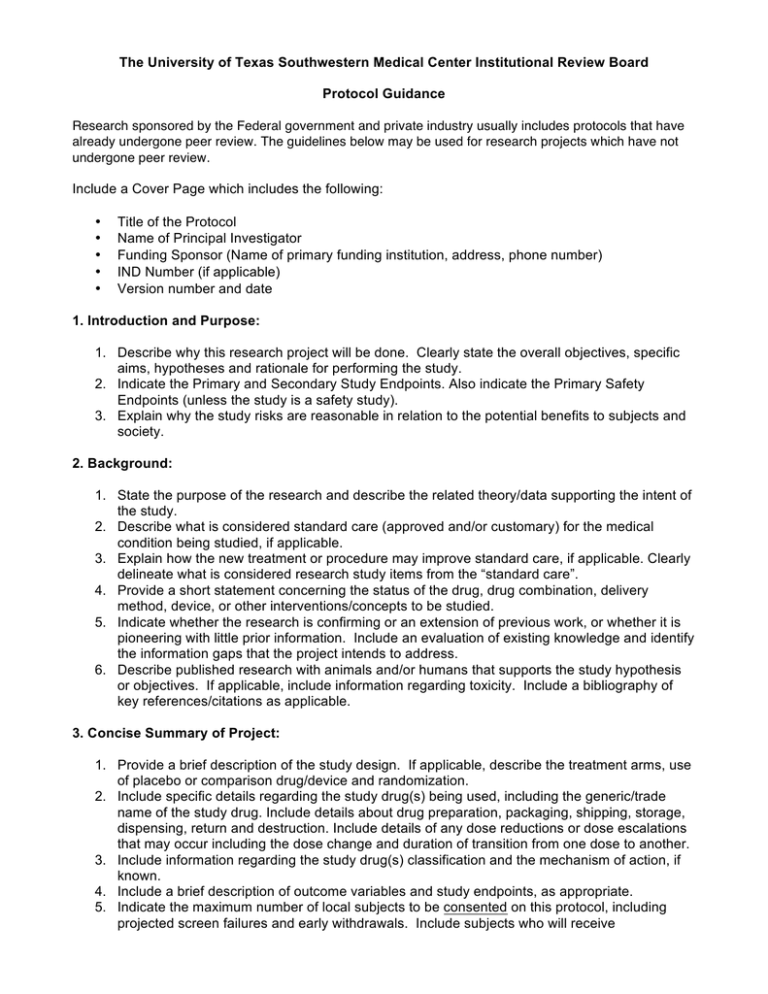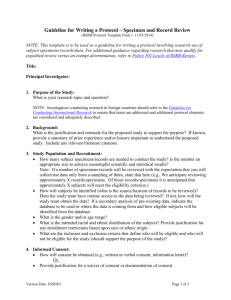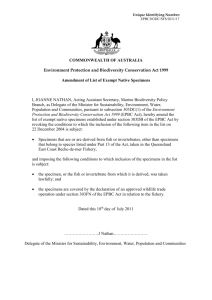The University of Texas Southwestern Medical Center Institutional Review Board
advertisement

The University of Texas Southwestern Medical Center Institutional Review Board Protocol Guidance Research sponsored by the Federal government and private industry usually includes protocols that have already undergone peer review. The guidelines below may be used for research projects which have not undergone peer review. Include a Cover Page which includes the following: • • • • • Title of the Protocol Name of Principal Investigator Funding Sponsor (Name of primary funding institution, address, phone number) IND Number (if applicable) Version number and date 1. Introduction and Purpose: 1. Describe why this research project will be done. Clearly state the overall objectives, specific aims, hypotheses and rationale for performing the study. 2. Indicate the Primary and Secondary Study Endpoints. Also indicate the Primary Safety Endpoints (unless the study is a safety study). 3. Explain why the study risks are reasonable in relation to the potential benefits to subjects and society. 2. Background: 1. State the purpose of the research and describe the related theory/data supporting the intent of the study. 2. Describe what is considered standard care (approved and/or customary) for the medical condition being studied, if applicable. 3. Explain how the new treatment or procedure may improve standard care, if applicable. Clearly delineate what is considered research study items from the “standard care”. 4. Provide a short statement concerning the status of the drug, drug combination, delivery method, device, or other interventions/concepts to be studied. 5. Indicate whether the research is confirming or an extension of previous work, or whether it is pioneering with little prior information. Include an evaluation of existing knowledge and identify the information gaps that the project intends to address. 6. Describe published research with animals and/or humans that supports the study hypothesis or objectives. If applicable, include information regarding toxicity. Include a bibliography of key references/citations as applicable. 3. Concise Summary of Project: 1. Provide a brief description of the study design. If applicable, describe the treatment arms, use of placebo or comparison drug/device and randomization. 2. Include specific details regarding the study drug(s) being used, including the generic/trade name of the study drug. Include details about drug preparation, packaging, shipping, storage, dispensing, return and destruction. Include details of any dose reductions or dose escalations that may occur including the dose change and duration of transition from one dose to another. 3. Include information regarding the study drug(s) classification and the mechanism of action, if known. 4. Include a brief description of outcome variables and study endpoints, as appropriate. 5. Indicate the maximum number of local subjects to be consented on this protocol, including projected screen failures and early withdrawals. Include subjects who will receive interventions as well as controls, if applicable. For multi-center research, indicate the total sample size for the entire project across all sites. 6. If the study involves use of existing charts, records, or specimens, specify the maximum number that will be reviewed to compile the data or the sample population necessary to address the research question. 7. Provide the total number of subjects to be studied at this site and approximately how long the study will last. 8. Include conditions which would result in the subject exiting the study prior to the expected completion date, such as non-compliance, safety reasons, subject withdrawal of consent, disease progression, etc. 4. Study Procedures: 1. Provide a chronological description of all study procedures. If applicable, divide procedures into pilot, screening, and procedures performed at each regular visit. Indicate how many total visits and approximately how long visits will last. For studies that are providing medication(s), give the name(s), dosage, and route of administration. For studies that have more than one arm/part, provide the above information for each. 2. You may include tables, figures and/or flow diagrams if necessary to clarify highly complex studies. 3. Indicate the timing of all study procedures and the anticipated duration of the subject’s involvement. 4. As applicable, include the amount and blood to be drawn, tissue samples to be collected, radiation exposure, questionnaires, or other interventions. 5. Note if the subject will be responsible for any research-related costs and estimate the amount of these costs, if applicable. 6. If applicable, describe end-of-study procedures, including transition of the subject to alternative care. 5. Sub-Study Procedures: 1. For any sub-studies that may be a part of the research, please provide a subsection title and include information about the procedures that will be performed and whether subjects have the option to participate or not (e.g., pharmacokinetics, biomarkers). 2. For studies that collect blood and/or tissue for DNA analysis where the genetic portion is described in the Master Protocol provide a genetic subsection to include information about the procedures that will be performed and whether subjects have the option to participate in the sub-study. 6. Criteria for Inclusion of Subjects: 1. Describe the characteristics of the subject population. For example, list any characteristics required for eligibility, such as diagnosis, prior therapy, age, or gender. 2. Explain the rationale for the use of special classes of subjects who are more likely to be vulnerable, such as pregnant women, children, cognitively impaired people or prisoners. 7. Criteria for Exclusion of Subjects: 1. Describe the exclusion criteria. For example, list any characteristics that would preclude participation, such as prior therapy, concomitant treatments and co-morbid conditions. If exclusion is based on age, gender, language barriers or social/ethnic group, describe the need for the exclusion in terms of scientific validity. Do not justify exclusion in terms of convenience or other non-scientific issues, such as lack of funding. 2. Include situations or conditions, unknown at the time of enrollment that might cause a screening failure. 8. Sources of Research Material: 1. Identify the source(s) of materials/data to be used in the research, such as information or specimens from medical records, databases, repositories or other sources. If a combination of these sources are used, and/or new clinical data generated, describe how the research material is acquired. 2. State whether the material or data will be obtained specifically for research purposes, or whether existing records, specimens or other data will be used. If existing records or specimens are being used, please indicate the dates from which data or samples will be extracted (start and stop dates). 9. Recruitment Methods and Consenting Process: 1. Indicate if the potential subjects will be patients of the investigators. 2. Describe and provide details of the recruitment process. Include when, where, by whom and how potential subjects will be approached. Indicate if non-English speaking subjects are being consented and if so, indicate how informed consent process will be conducted. 3. Explain measures that will be taken to respect the privacy of the potential subjects. 4. Explain what precautions will be taken to minimize the potential for undue influence or coercion. 5. If you are requesting a waiver of informed consent, explain how the criteria for waiver are met. 6. If vulnerable populations will be included, describe the additional protections that will be provided, such as methods to obtain surrogate consent (cognitively impaired subjects), and plans for obtaining assent and/or the permission of one or both parents (minors). 10. Potential Risks: 1. Describe the known risks and/or potential discomforts associated with each intervention or research procedure. Risks may be physical, psychological, social or economic. 2. Estimate the probability (chance or likelihood of occurrence) that a given harm may occur and its severity (mild, moderate or severe) and define risks by percentages, when available, or by categorizing with the terms rare, unlikely, likely. 3. Compare the risks of the research to standard of care. If placebo controls are used, justify their use over active or other kinds of controls. 11. Subject Safety and Data Monitoring: 1. Describe what measures have been taken and/or will be taken to prevent and minimize any risks or discomforts. 2. If applicable, discuss provisions for insuring necessary medical or professional intervention in the event of adverse events. 3. Describe the plan for monitoring study data collected to protect subject safety and data integrity. Please review Guidance on Data and Safety Monitoring Plans document for instructions on what information should be provided. If desired, the DSMP Template may be used and included in your application packet. 4. Note: investigator-initiated studies involving administration of an experimental (i.e. not FDA approved for the indication/population under study) drug, device or intervention must submit a Data Safety Monitoring Plan (DSMP Template) and may be required by the IRB to establish a Data Safety monitoring Board (DSMB). 12. Procedures to Maintain Confidentiality: 1. Describe how data/specimens will be collected and stored and the security methods in place. Note: the more sensitive the study data, the more sophisticated the methods should be to maintain confidentiality. 2. If data/specimens will be disclosed to outside persons or entities, list the entities and the method used to code or de-identify the data/specimens. 3. State if you intend to apply for a Certificate of Confidentiality from the NIH. 13. Potential Benefits: 1. Describe the potential benefits of the research to the subjects, to others with similar problems, and to society. If there is no prospect of direct benefit to the subjects, state how the knowledge to be gained will benefit society enough to justify any risks to subjects. 14. Biostatistics: (omit this section for peer-reviewed research such as cooperative group, or NIHsponsored studies, and for industry-sponsored research which has been submitted to FDA) 1. Describe the statistical methods to be used to answer the study question(s). Pilot studies also require a method of analysis, but the justification of the target sample size is not required. 2. Explain how the target sample size was determined.







